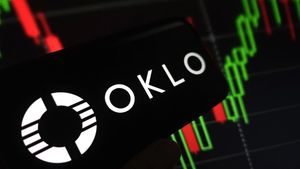
In a move set to ignite both the energy and technology sectors, Fermi America is poised to launch its initial public offering (IPO) on October 1, 2025. The new energy and data center developer, co-founded by former U.S. Energy Secretary Rick Perry, is seeking to raise over half a billion dollars to fund an ambitious project in Texas, which notably includes a power generation facility named after former President Donald J. Trump. This high-profile offering presents a unique opportunity for investors to back a venture at the intersection of advanced nuclear technology, hyperscale data centers, and the surging demands of artificial intelligence.
The impending IPO of Fermi America (NASDAQ: FRMI, LSE: FRMI) has captured significant attention due to its audacious vision: to create self-sufficient "HyperGrid" campuses that integrate power generation directly with massive AI data centers. With the IPO just days away, the financial markets are closely watching how investors will react to a company with no operating history but a compelling narrative centered on energy independence, technological innovation, and a politically charged naming convention. The success of this offering could signal a new era of private investment in large-scale, integrated energy infrastructure, particularly in the realm of nuclear power.
Project Matador: Powering the AI Revolution with a Presidential Name
Fermi America, established in January 2025, is spearheaded by a team including Rick Perry and CEO Toby Neugebauer. The company positions itself as a real estate investment trust (REIT) focused on developing integrated energy and data center complexes designed to meet the insatiable power demands of artificial intelligence. Its flagship undertaking, "Project Matador – The President Donald J. Trump Advanced Energy and Intelligence Campus," is slated for construction near Amarillo, Texas, on a vast tract of land leased from the Texas Tech University System.
This sprawling campus, spanning over 5,000 acres, aims to be the world's largest energy-driven AI complex. The core of its strategy is "behind-the-meter" power generation, ensuring a direct and reliable energy supply to co-located data centers, thereby reducing reliance on the public grid. The energy mix is highly diverse and ambitious, featuring plans for four Westinghouse AP1000 pressurized water reactors, with the first expected to break ground in 2026 and become operational by April 2031. Additionally, the project incorporates 1.1 GW of combined-cycle natural gas facilities secured for 2026 delivery, alongside solar power and battery energy storage. The company targets delivering up to 11 gigawatts (GW) of low-carbon, on-demand power by 2038, with an initial 1.1 GW projected to be online by the end of 2026. The explicit naming of the plant after Donald J. Trump, as articulated by Rick Perry, aims to align the project with a vision of American energy dominance and a revival of nuclear power.
Fermi America plans to offer 25 million shares in its IPO, with an anticipated price range of $18 to $22 per share, aiming to raise between $450 million and $550 million. The company is targeting an ambitious valuation of up to $13 billion. Proceeds from the offering are earmarked for business growth, personnel expansion, enhancing financial flexibility, and crucial corporate purposes, including the procurement and installation of long lead-time items necessary for its complex infrastructure.
Winners and Losers in the AI Energy Arms Race
The success of Fermi America's ambitious project could create significant opportunities and challenges for various players in the energy and technology sectors. Westinghouse Electric Company, as the provider of the AP1000 reactors, stands to be a major beneficiary, potentially securing substantial contracts for reactor construction and maintenance, bolstering its position in the global nuclear power market. Similarly, suppliers of natural gas turbines, solar panels, and battery storage solutions could see increased demand. Companies specializing in large-scale construction and engineering services would also be in a prime position to win contracts for Project Matador.
On the demand side, hyperscale data center operators and leading artificial intelligence companies that require immense, reliable, and low-carbon power could be significant "winners" by becoming tenants at the Fermi campus. Companies like Microsoft (NASDAQ: MSFT), Google (NASDAQ: GOOGL), and Amazon (NASDAQ: AMZN), which are heavily investing in AI infrastructure, could find Fermi's integrated power solution highly attractive, offering a unique value proposition compared to traditional data center locations. Their demand for stable, high-capacity power is a key driver for Fermi's business model.
However, the project also poses potential challenges for existing energy providers and grid operators. If Fermi America successfully develops its "behind-the-meter" generation capabilities, it could reduce the reliance of major energy consumers on established utility companies, potentially impacting their revenue streams and long-term planning. Furthermore, the sheer scale of Fermi's proposed generation capacity, particularly its nuclear component, could introduce new competitive pressures into regional energy markets, especially within the Electric Reliability Council of Texas (ERCOT) grid. Companies that fail to adapt to the growing demand for sustainable, on-demand power for AI may find themselves at a disadvantage.
Broader Implications: Reshaping Energy, Data, and Policy Landscapes
Fermi America's venture fits squarely into several significant broader industry trends. Firstly, it highlights the escalating energy demands of artificial intelligence. As AI models grow more complex and widespread, the power required to train and run them is becoming a critical constraint. Fermi's integrated approach directly addresses this, proposing a model where power generation is purpose-built for AI compute. Secondly, it signals a potential resurgence of interest in nuclear power, particularly advanced and modular reactors, as a reliable, low-carbon baseload energy source. This aligns with a growing global recognition of nuclear's role in decarbonization efforts, despite its high upfront costs and long development timelines.
The project's political overtones, including the involvement of Rick Perry and the naming of the plant after Donald J. Trump, carry significant regulatory and policy implications. It could galvanize support for pro-nuclear and energy independence policies, potentially influencing future federal and state incentives for advanced energy projects. Historically, large-scale infrastructure projects, especially nuclear ones, have faced extensive regulatory hurdles, public opposition, and significant delays, as evidenced by the long and costly construction of the Vogtle Electric Generating Plant in Georgia by Southern Company (NYSE: SO). Fermi America acknowledges these execution risks, and its ability to navigate them will be a critical test.
Potential ripple effects on competitors and partners are substantial. Traditional utility companies might be compelled to accelerate their own decarbonization and grid modernization efforts to compete with the integrated, low-carbon solutions offered by Fermi. Technology companies, on the other hand, may increasingly seek out similar "behind-the-meter" power solutions or even explore developing their own energy infrastructure to secure future AI capacity. The project could also set a precedent for public-private partnerships in critical infrastructure, especially if it garners government support or loans, such as those from the Department of Energy.
What Comes Next: A Decade of Development and Market Scrutiny
In the short term, all eyes will be on Fermi America's IPO performance on October 1, 2025. A successful capital raise is crucial for the company to move beyond its conceptual stage and begin the arduous process of site development and procurement. Following the IPO, the immediate next steps will involve securing further financing, initiating detailed engineering and design work, and commencing construction of the natural gas facilities, which are projected to be online by late 2026. The procurement of long-lead-time items for the nuclear reactors will also be a critical early milestone.
The long-term possibilities for Fermi America hinge on its ability to execute its ambitious construction timelines, particularly for the nuclear components which are not expected to be operational until 2031. Successful completion of Project Matador could establish a new paradigm for energy-intensive industries, offering a blueprint for other regions or countries facing similar energy constraints for AI development. Conversely, significant delays or cost overruns, akin to historical nuclear projects, could severely challenge the company's financial viability and investor confidence.
Market opportunities will emerge for companies providing specialized construction, nuclear engineering, and data center management services. Challenges will include navigating complex regulatory environments, managing supply chain risks for critical components, and attracting and retaining the highly specialized workforce required for such a sophisticated project. Investors should anticipate a period of significant capital expenditure and negative cash flow for several years, as tenant revenue is not expected until 2027. Potential scenarios range from Fermi becoming a trailblazer in integrated energy-AI infrastructure to facing substantial headwinds that delay or even derail its grand vision.
A High-Stakes Bet on the Future of Energy and AI
Fermi America's impending IPO represents a high-stakes wager on the future convergence of energy generation and artificial intelligence. The project, with its politically charged name and ambitious scope, encapsulates several key takeaways: the escalating demand for reliable, low-carbon power driven by AI; the potential for a renewed focus on nuclear energy solutions; and the growing trend of integrating power generation directly with compute infrastructure. While the company presents a compelling vision for energy independence and technological advancement, investors must weigh this against the significant execution risks, the company's lack of operating history, and the notoriously long development cycles and high costs associated with nuclear power projects.
Moving forward, the market will be closely assessing Fermi America's ability to meet its aggressive timelines and secure the necessary additional financing beyond the IPO proceeds. Investors should watch for progress on construction milestones, updates on regulatory approvals, and any announcements regarding tenant agreements for its data center capacity. The performance of its initial natural gas facilities by 2026 will provide an early indicator of its operational capabilities. The success or failure of Project Matador will not only impact Fermi America and its shareholders but could also profoundly influence the future trajectory of large-scale energy infrastructure development and the broader AI industry's energy strategy. This content is intended for informational purposes only and is not financial advice





